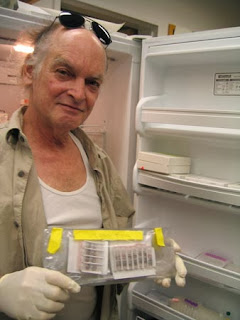 |
| Presentation Room |
Shortly after the Joyce Cutler Shaw gallery ended, the LASER presentation began right across the hall. Coming in I honestly thought they were going to be shooting a giant laser into space. I'm not sure why. To my surprise I was able to attend a presentation by scientists and doctors in fields I didn't even think existed.
 |
| Robert Bilder |
The first project that was presented was the Big C Project by Robert Bilder. Robert studied the biology of creativity, a field I had never even heard of before. He studied birds to see how they create songs, because this diversity could be tracked mathematically and linked to the growth of their brains. He wanted to see if there was a difference between Big C which referred to creative genius vs. Little C which referred to everyday acts of creativity. His research was very new to me, and I didn't think it was possible to scientifically track something as unique as creativity. His work really blew me away.
 |
| Professor Vesna introducing Ping Ho |
The next presenter I want to highlight is Ping Ho who is the founding director of Healing and the Arts. She is a doctor who studied healing through creativity, something which at first I thought to be a complete myth. Her research showed that by applying creative medecine to cancer patients she was able to significantly lower stress, pain, and increase resistance to a disease. They say that positive thinking and hobbies are the most important thing when healing, but Ping Ho took this saying and made it into a science.
 |
| Crumpled Piece of Paper |
At the end of Ping Ho's presentation she gave everyone a piece of paper and pencil and told us to use the paper to show what "stress" is. Most people in the room crumpled up the paper while I took the liberty of writing all over it, then crumpling it up, ripping it into tiny pieces, and throwing it in the air. That's when Ping Ho told us, "That's how you deal with stress." Such a simple experiment made so much to sense to me. It was probably the highlight of my night.
 |
| Professor Vesna's Refreshments |
Thank you for the refreshments professor!
Citations:
1.
Robert Bilder. Digital image. Health Sciences. UCLA, n.d. Web. 13 Dec. 2013. <http://people.healthsciences.ucla.edu/institution/photo?personnel_id=10128>.
2.
Crumpled Paper. Digital image. LA Weekly. N.p., n.d. Web. 13 Dec. 2013. <http://blogs.laweekly.com/informer/20070429-crumpled-paper.jpg>.
























